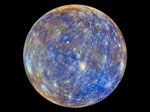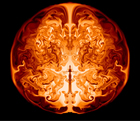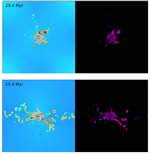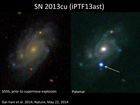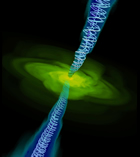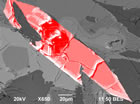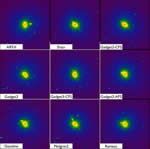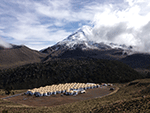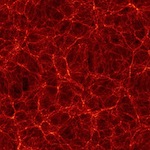Word doc
PDF (formatted and ready to go as a single newsletter page)
Planet Formation: More Questions Than Answers
847 and counting: that’s the number of planets confirmed as existing around 642 stars within several hundred light-years of our Sun. And more than 2,000 additional detections are awaiting confirmation by follow-up observations. By far, the most potential exoplanets have been found by the NASA spacecraft Kepler (launched in 2009), whose mission is to find Earthlike planets in a habitable zone around other stars, by staring at 150,000 stars and recording minuscule dips in brightness.
So far, Kepler hasn’t yet found an identical twin to Earth: a rocky body of similar mass, sweet with liquid water, in the “Goldilocks zone” for temperatures just right for life as we know it to evolve. In fact, Kepler hasn’t yet found even an exoplanetary system resembling our Solar System, with rocky planets on the inside, gas giants in the outer reaches, and orbital periods ranging from months to centuries. Instead, most exoplanetary systems are—by the standards of our Solar System—so bizarre they are challenging astronomers and computational astrophysicists to reexamine long-held models of how planets form
Constrained by the data
“With many observations, theorists have less freedom to speculate how planets form,” explains Brad M. S. Hansen, associate professor of physics and astronomy at the University of California, Los Angeles. “Any theoretical or computational models have to explain what we actually find.”
One big early surprise (1995) was the ground-based discovery of “hot Jupiters:” gas giants the size of Jupiter in orbits around their parent stars much closer than Venus—or even Mercury—is to the Sun. How does something that massive form so close to a parent star? Would there have been enough material for such a big body to form in place, without being ripped apart by tidal forces? Or might it accrete from dust and rocks farther out in its planetary system and later migrate inward toward its parent star?
Later, lower mass, rocky planets—“super-Earths” only a few times the mass of Earth—were identified from Kepler data. “Now there also is an intermediate class of ‘hot Neptunes’ midway between the super-Earths and the hot Jupiters,” Hansen continues. In a paper published in June 2012, he and coauthor Norm Murray describe an analysis of their formation from a set of numerical simulations based on a purely gravitational calculation of planetary scattering, collision and assembly.
Meantime, in December 2011, confirmation was announced of two rocky Earth-sized planets in the Kepler-20 system. They are two of five planets orbiting a G-type star a little smaller and cooler than our Sun. But the entire planetary system could almost fit inside the orbit of Mercury; both Earth-sized planets zoom around their star in less than three weeks; the three other planets are slightly smaller than Neptune; and the sequence of planets from star outward neatly alternates large-small-large-small-large.

The first Earth-sized planets were found in December 2011 by NASA’s Kepler mission around a sun-like star Kepler-20. Kepler-20e is slightly smaller than Venus with a radius 0.87 that of Earth; Kepler-20f is a bit larger than Earth at 1.03 times the radius of Earth. Both are rocky but with scorching temperatures, as their “years” (orbital periods) are only 6.1 and 19.6 days, respectively. Three larger, likely gaseous, planets also circle Kepler-20.
Image credit: NASA/Ames/JPL-Caltech (view a slightly different version of the above image here)
Working models
So what do the observations and calculations tell astrophysicists about how planetary systems form?
One key is the relative distribution of mass among planets in a system. “Higher mass systems seem consistent with planets assembling in place,” Hansen says. “That is somewhat unsettling because the mass required for in situ formation is a hundred times what we see in our own Solar System.” One possibility is that the mass still moved radially inward, but early when it was smaller chunks like gravel, boulders, or asteroids.
That still leaves an important question: what processes in a whirling solar nebula allow smaller chunks to stick together to accrete larger objects and eventually planets? Especially, notes Hansen, “the dust-to-pebbles step is poorly understood.”
One possibility is very cold temperatures. “At 100K, small objects may be covered with water ice, dry ice, and other ices,” Hansen says, “so when objects collide, they stick together. My money is on another possibility suggested by fluid-dynamics simulations: turbulence in the collapsing solar nebula causing some fluid wavelike behavior in local areas of the gravitational collapse that triggers a jump from dust to boulders.”
Stay tuned! –Trudy E. Bell, M.A.
Further reading: Hansen, Brad M.S., and Norm Murray, “Migration then assembly: Formation of Neptune mass planets inside 1 AU,” Astrophysical Journal 751 (2): 158–174 (06/2012)http://iopscience.iop.org/0004-637X/751/2/158/
The University of California High-Performance AstroComputing Center (UC-HIPACC), based at the University of California, Santa Cruz, is a consortium of nine University of California campuses and three Department of Energy laboratories (Lawrence Berkeley Laboratory, Lawrence Livermore Laboratory, and Los Alamos National Laboratory). UC-HiPACC fosters collaborations among researchers at the various sites by offering travel and other grants, co-sponsoring conferences, and drawing attention to the world-class resources for computational astronomy within the University of California system. More information appears at http://hipacc.ucsc.edu .

